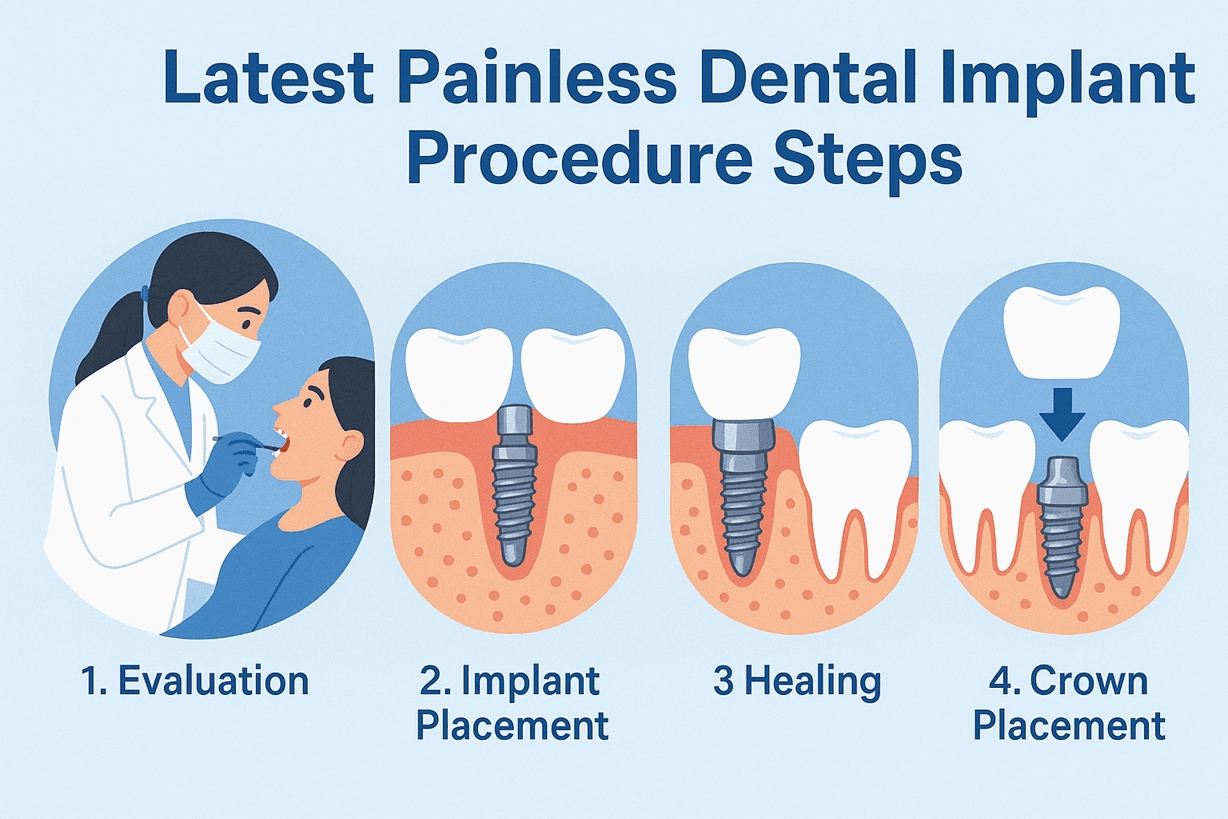Latest Painless Dental Implant Procedure Steps: A Comprehensive Guide

Why Choose Dental Implants? Understanding the Benefits
Dental implants have become the gold standard for replacing missing teeth, offering a durable and natural looking solution. But why are so many people opting for implants over other options like dentures or bridges? The benefits of the dental implant procedure are numerous:
Durability: Implants are designed to last a lifetime with proper care.
Natural Look and Feel: They function and appear like natural teeth, restoring your smile and confidence.
Improved Oral Health: Unlike bridges, implants don't require altering adjacent teeth, preserving more of your natural teeth. They also stimulate bone growth, preventing bone loss that can occur with missing teeth.
Enhanced Function: Implants allow you to eat, speak, and laugh comfortably without worrying about slippage or discomfort.
However, many people are hesitant due to concerns about pain and lengthy procedures. The good news is that advancements in tooth implant surgery and technology have made the process significantly more comfortable and efficient.
Are You an Ideal Candidate for a Painless Dental Implant Procedure?
Not everyone is automatically a good candidate for dental implants. Key factors determine suitability in the step by step dental implant procedure:
Sufficient Bone Density: Implants require adequate bone to fuse with. If you have significant bone loss, bone grafting might be necessary as part of the implant treatment.
Good Overall Health: Certain medical conditions like uncontrolled diabetes or autoimmune diseases can affect healing and implant success.
Healthy Gums: Gum disease needs to be treated before implant placement to prevent infection and ensure long-term stability.
Commitment to Oral Hygiene: Implants require diligent brushing, flossing, and regular dental check-ups for optimal longevity.
Even if you have some of these issues, it doesn't automatically disqualify you. Advances in implant procedure steps and materials often allow for successful placement even in challenging cases. Consulting with a qualified implant dentist is crucial to determine your individual suitability.
Key Innovations for Pain-Free Dental Implant Process Step by Step
Several technological advancements have revolutionized dental implant procedure steps, making them less painful, more precise, and faster than ever before. Here are the most impactful innovations:
Advanced Technique: 3D Imaging and Planning
One of the most significant advancements in the dental implant process step by step is the use of 3D imaging, specifically Cone Beam Computed Tomography (CBCT).
What it is: CBCT provides a detailed, three-dimensional view of your jawbone, teeth, and surrounding structures.
How it helps: This allows dentists to precisely plan tooth implant surgery, avoiding nerves, sinuses, and other critical anatomical structures. Previously, dentists relied on 2D X-rays, leading to larger incisions and a more invasive approach.
Benefit: Increased accuracy, reduced risk of complications, and a less invasive procedure, resulting in less discomfort and a faster recovery.
Advanced Technique: Minimally Invasive Procedures (Flapless Surgery)
Traditional implant surgery often involves making a large incision in the gums (creating a “flap”) to expose the bone. Minimally invasive techniques, known as flapless surgery, aim to reduce tissue disruption.
What it is: Flapless surgery involves placing the implant through a small, precisely created opening in the gums, guided by 3D imaging and surgical guides.
How it helps: It reduces the need for extensive incisions, leading to less bleeding, swelling, and pain.
Benefit: Faster healing times, reduced discomfort, and fewer post-operative complications.
Important Note: Not all patients are candidates for flapless surgery. It depends on bone density, gum health, and the location of the implant. A thorough evaluation is necessary.
Advanced Technique: Immediate Load Implants (Same-Day Implants)
Traditionally, after placing an implant, there is a waiting period of several months (osseointegration) before a crown can be attached. Immediate load implants offer a faster solution in the dental implant procedure step by step pictures shown by many clinics.
What it is: This involves placing the implant and attaching a temporary crown on the same day.
How it helps: Patients can leave the clinic with a functional tooth, improving aesthetics and function immediately.
Benefit: Faster results, improved confidence, and reduced treatment time.
Important Note: Immediate load implants require excellent bone quality and stability. Your dentist will assess your situation to determine your suitability.
Advanced Technique: Enhanced Osseointegration Methods
Osseointegration, the process of the implant fusing with the jawbone, is crucial for the success of the dental implant procedure. Innovations in implant surface technology have significantly improved osseointegration rates and speed.
What it is: Implant manufacturers now use special surface treatments (e.g., nano-textured surfaces) to enhance the implant's ability to bond with bone. Growth factors like Platelet-Rich Fibrin (PRF) are also used.
How it helps: These treatments create a favourable environment for bone growth, accelerating healing and improving stability.
Benefit: Faster healing, better implant stability, and higher success rates, even in patients with compromised bone quality.
Advanced Technique: Robotic-Assisted Implant Surgery
Robotics is revolutionizing implant procedure steps, offering greater precision and predictability.
What it is: Robotic-assisted surgery uses a robotic arm guided by pre-operative 3D planning to precisely place the implant.
How it helps: This allows for even more accurate placement, minimizing risks.
Benefit: Enhanced precision, minimally invasive techniques, and improved long-term outcomes.
Although still relatively new, robotic-assisted implant treatment holds immense promise for the future of dental care.
Preparing for Your Dental Implant Procedure and Post-Operative Care
Proper preparation and aftercare are essential for a successful, painless dental implant procedure step by step experience.
Initial Consultation: A thorough examination, including X-rays or CBCT scans, to assess suitability. Your dentist will review your medical history and discuss treatment options.
Pre-Surgery Instructions: You may receive guidelines about medications, diet, and oral hygiene before surgery.
Pain Management: Modern techniques use local anaesthesia to numb the area. Sedation options like nitrous oxide or oral sedation are available for anxious patients.
Post-Surgery Care: Follow your dentist’s instructions, take pain medication if needed, use ice packs for swelling, and eat a soft diet for a few days.
Long-Term Maintenance: Implants require the same care as natural teeth brushing, flossing, and regular check-ups to prevent peri-implantitis, an infection that can damage the implant.

